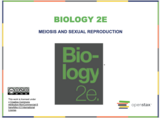
928 Results



The theory of evolution is the unifying theory of biology, meaning it is the framework within which biologists ask questions about the living world. Its power is that it provides direction for predictions about living things that are borne out in ongoing experiments. The Ukrainian-born American geneticist Theodosius Dobzhansky famously wrote that “nothing makes sense in biology except in the light of evolution.” He meant that the tenet that all life has evolved and diversified from a common ancestor is the foundation from which we approach all questions in biology.


This chapter outlines information on the regulation of gene expression in both prokaryotes and eukaryotes. This includes transcriptional, post-transcriptional, translational and post-translational regulation.


IntroductionThis chapter covers the details of the Central dogma including transcription and translation. Prokaryotic and eukaryotic transcription are compared. Eukaryotic RNA processing is described. Protein synthesis is outlined including protein folding and modifications of the newly created proteins.


Animal evolution began in the ocean over 600 million years ago with tiny creatures that probably do not resemble any living organism today. Since then, animals have evolved into a highly diverse kingdom. But what is an animal? While we can easily identify dogs, birds, fish, spiders, and worms as animals, other organisms, such as corals and sponges, are not as easy to classify. Animals vary in complexity—from sea sponges to crickets to chimpanzees—and scientists are faced with the difficult task of classifying them within a unified system. They must identify traits that are common to all animals as well as traits that can be used to distinguish among related groups of animals. The animal classification system characterizes animals based on their anatomy, morphology, evolutionary history, features of embryological development, and genetic makeup. This classification scheme is constantly developing as new information about species arises. Understanding and classifying the great variety of living species help us better understand how to conserve the diversity of life on earth.


Meiosis is the process of cell division that produces haploid gametes. In sexual reproduction haploid gametes combine through fertilization to form a genetically recombined diploid zygote. Meiosis includes two successive divisions and processes such as crossing over and independent assortment that increase genetic variability in gametes produced. Life cycles detail the events between meiosis and fertilization that vary for different multicellular organisms.


Genetics is the study of heredity. Johann Gregor Mendel set the framework for genetics long before chromosomes or genes had been identified, at a time when meiosis was not well understood. Mendel selected a simple biological system and conducted methodical, quantitative analyses using large sample sizes. Because of Mendel’s work, the fundamental principles of heredity were revealed. We now know that genes, carried on chromosomes, are the basic functional units of heredity with the capability to be replicated, expressed, or mutated. Today, the postulates put forth by Mendel form the basis of classical, or Mendelian, genetics. Not all genes are transmitted from parents to offspring according to Mendelian genetics, but Mendel’s experiments serve as an excellent starting point for thinking about inheritance.


The cellular processes of life require energy. How do living organism obtain energy and how is it used? This Chapter answers these questions by exploring forms of energy and energy transfer within and between living organisms, as well as the role of enzymes and adenosine triphosphate (ATP) in chemical reactions in cells.


This chapter begins with the details of the Chromosome Theory of Inheritance and moves onto discuss homologous recombination and the creation of new chromosomes. It also describes genetic linkage maps and how to calculate distances of genes on chromosomes. The second part of this chapter is focused on karyotypes, nondisjunction and creation of individuals with abnormal numbers of chromosomes.


Virtually all life on Earth depends on Photosynthesis. Photosynthesis uses energy in sunlight to form organic molecules such as glucose. This transformation of light energy to chemical energy provides fuel for the metabolic processes in all organisms. Photosynthesis also produces oxygen required for aerobic cellular respiration. This chapter covers light energy as part of the electromagnetic spectrum, basic structures involved in photosynthesis and the metabolic pathways of photosynthesis divided into the light-dependent reactions and the Calvin cycle.
